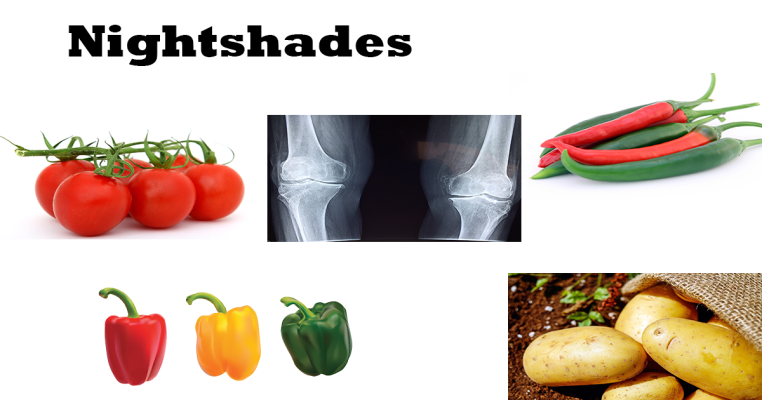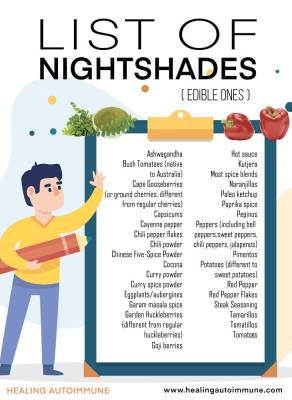 If you suffer from inflammation, joint pain and cracking, avoiding nightshades will likely lessen your pain, whether or not the nightshades are the true source of the pain
If you suffer from inflammation, joint pain and cracking, avoiding nightshades will likely lessen your pain, whether or not the nightshades are the true source of the pain
The nightshades are members of an enormous family of plants called Solanaceae, represent a huge family of plants. Muscle pain and tightness, morning stiffness, poor healing, arthritis, insomnia and gall bladder problems—these can all be caused by nightshades. Nightshades can also cause heart burn or GERD
Am i eating Nightshade foods?
The ones that concern us in the Western diet mainly include tomatoes, potatoes (not sweet potatoes or yams), eggplant and peppers—this means all peppers including chili peppers, habenero, cayenne pepper and paprika (not peppercorns, see sidebar). Paprika is a sneaky one, showing up in lots of flavoring mixes and often under “spices” on ingredient labels. Other nightshades include goji berries (the new darling of the antioxidant crowd), ashwagandha (an adaptogenic herb from Ayurvedic medicine), Cape gooseberries (not normal gooseberries), ground cherries and garden huckleberries (not blueberries).
How does it effect the joints if i am a person who is sensitive to Nightshade foods?
The nightshades are considered a “calcinogenic” plant; that is, they cause calcinosis, which is a toxic calcication of soft tissues when eaten by animals. This happens because they contain calcitriol (1,25-dihydroxy vitamin D), the most active form of vitamin D. Please note that calcitriol is not vitamin D (cholecalciferol), an extremely important distinction. Calcitriol signals the intestines to absorb calcium from our diet. While we absolutely need calcitriol to maintain proper bone density, too much calcitriol, from any source, leads to hypercalcemia, also known as high blood calcium. The body does not like this situation and wants to get the calcium levels back down to normal as quickly as possible, as an imbalance of minerals in the blood particularly affects the heart. The quickest solution for the body is to deposit the extra calcium into the soft tissues. Each hypercalcemic episode likely lasts for only a short while, however, each episode leaves a small deposit behind. Over time, these deposits lead to the condition known as calcinosis
Overconsumption of calcitriol from nightshade foods can circumvent the kidney’s control and over time lead to calcium deposits in the soft tissues such as the tendons, ligaments, cartilage, cardiovascular tissues, kidneys and skin. Osteoarthritis is basically calcium deposits in the soft tissues of joints. Chronic hypercalcemia can lead to generalized vascular (blood vessel) calcication, which is coronary artery disease. Nephrocalcinosis is calcication of the kidneys
SOLANINE
Solanine is a glycoalkaloid, that is, a non-protein compound containing nitrogen. It is a potent poison found in species of the nightshade family, especially potatoes and eggplant. Solanine poisoning is primarily displayed by gastrointestinal and neurological disorders. Symptoms include nausea, diarrhea, vomiting, stomach cramps, burning of the throat, cardiac dysrhythmia, headache and dizziness. Hallucinations, loss of sensation, paralysis, fever, jaundice, dilated pupils and hypothermia have been reported in more severe cases
Solanine and related glycoalkaloids are poisonous because they are acetylcholinesterase inhibitors—they inhibit the breakdown of acetylcholine, resulting in increased level and duration of action of this neurotransmitter. What does this mean? They cause prolonged muscle contractions. This is why people who are sensitive to nightshades or eat a lot of them often feel stiff when they wake up in the morning or sit for extended periods
NICOTINE
All nightshades contain nicotine, which is why they can be addictive. Is nicotine a problem when we eat it? A large body of research shows that nicotine consumption inhibits proper healing. In one study, nicotine delayed tendon-tobone healing in a rat shoulder—the equivalent of our rotator cuff. A follow-up study by the same authors showed that delayed healing in tendon-to-bone injuries resulted in inferior permanent healing of the area
CAPSAICIN
Capsaicin is an alkaloid found in hot peppers. We use it in herbal medicine regularly, it has anti-inammatory properties. It can actually be an irritant for mammals, including humans, and produces a sensation of burning in any tissue it comes in contact with. Spicy peppers contain capsaicin, it is the active ingredient in pepper spray is capsaicin. It can shut down the lungs—this is why some people have died from pepper spray. Asthmatics would do well to avoid capsaicin in general. They actually use capsaicin in animal studies to stimulate something very much like an asthma attack. Substance P is released from the terminals of specific sensory nerves. It is found in the brain and spinal cord and is associated with inflammatory processes and pain—it acts as a neurotransmitter to carry pain signals to the nervous system. Capsaicin makes your nerves release almost all the substance P they have, and researchers have therefore suggested that drugs containing capsaicin can help reduce pain. For example, there is an over-thecounter cream containing capsaicin that is promoted to help deplete substance P from local nerve endings and relieve pain However, inducing massive releases of substance P on a regular basis is like taking speed until your adrenals run out of adrenaline; it leads to a chronic local or systemic depletion of substance P. Substance P is necessary for proper healing. The brain gets a signal from substance P telling it that something is hurt and needs to be fixed. So when you have diabetics using capsaicin cream for their neuropathy, they feel better—the pain signal is gone—but they are inhibiting the healing process.
 A recent study looked at the use of capsaicin in insulin-dependent diabetic rats. The standard explanation for type 1 diabetes is malfunction and death of the insulin-producing islet cells in the pancreas. Another theory holds that malfunction of the pain nerves surrounding cells in the pancreas can cause type 1 diabetes. Researchers have found that
the islet cells in diabetics are surrounded by large numbers of pain nerves that signal to the brain that pancreatic tissue is damaged. When the researchers injected Substance P into the rats, the islet cells began producing insulin normally almost immediately. They also produced insulin for about a month when they were injected with capsaicin.
Capsaicin depletes substance P. Although this study was reported as showing a beneficial role for capsaicin, the proper conclusion is that capsaicin is likely horrible for diabetics and their blood sugar control. I have witnessed firsthand the negative impact of consuming peppers on blood sugar control in some of my diabetic patients (the ones who keep diet and blood glucose logs
Capsaicin receptors have been found in arthritic joints. When they inject capsaicin into mouse knee joints, it reduces blood ow. That’s a bad thing. Blood is what heals us. When neonatal rats were given capsaicin, their immune markers were depressed for ninety days.
In humans, increased consumption of peppers is associated with an increase risk of nasopharyngeal carcinoma and stomach cancer. Researchers found seventeen times (!) the risk of stomach cancer in people who self-rated themselves as high consumers of peppers. In people who had tissue biopsies of colon polyps, dysplasia and adenocarcinoma, researchers couldn’t nd any substance P in those biopsies. Where would it have gone? What they found was the presence of capsaicin receptors instead
A recent study looked at the use of capsaicin in insulin-dependent diabetic rats. The standard explanation for type 1 diabetes is malfunction and death of the insulin-producing islet cells in the pancreas. Another theory holds that malfunction of the pain nerves surrounding cells in the pancreas can cause type 1 diabetes. Researchers have found that
the islet cells in diabetics are surrounded by large numbers of pain nerves that signal to the brain that pancreatic tissue is damaged. When the researchers injected Substance P into the rats, the islet cells began producing insulin normally almost immediately. They also produced insulin for about a month when they were injected with capsaicin.
Capsaicin depletes substance P. Although this study was reported as showing a beneficial role for capsaicin, the proper conclusion is that capsaicin is likely horrible for diabetics and their blood sugar control. I have witnessed firsthand the negative impact of consuming peppers on blood sugar control in some of my diabetic patients (the ones who keep diet and blood glucose logs
Capsaicin receptors have been found in arthritic joints. When they inject capsaicin into mouse knee joints, it reduces blood ow. That’s a bad thing. Blood is what heals us. When neonatal rats were given capsaicin, their immune markers were depressed for ninety days.
In humans, increased consumption of peppers is associated with an increase risk of nasopharyngeal carcinoma and stomach cancer. Researchers found seventeen times (!) the risk of stomach cancer in people who self-rated themselves as high consumers of peppers. In people who had tissue biopsies of colon polyps, dysplasia and adenocarcinoma, researchers couldn’t nd any substance P in those biopsies. Where would it have gone? What they found was the presence of capsaicin receptors instead
What is the take home message regarding a Nightshade sensitivity?
How do you figure out whether nightshades are causing your medical problems? For many, no relief comes until the diet is totally clear of all these nightshades for at least six weeks. Many people notice an improvement in their pain; sometimes it goes away completely. If the person has strictly avoided the nightshades for six weeks, yet still doesn’t believe their pain has decreased, I suggest that they do a “nightshade party day”: salsa and eggs for breakfast, tomato and eggplant for lunch, potatoes for dinner—just have it all, and have a lot. Eat as much as you can in one day and then watch for symptoms over the next two days. Often there is a delayed onset reaction
Why are some people more sensitive than others?
Nutrient deficiencies certainly come into play. For example, if you don’t have enough magnesium, you will be more prone to calcinosis. Deficiency in vitamin D may exacerbate the problem. The speed at which one’s liver and kidneys detoxify these compounds plays a huge role, and this is dependent both on genetics and nutrition. A key nutrient is vitamin K. There is one study titled : The Effect of Vitamin K on Experimental Calcinosis. They gave rats calcinosis by giving them way too much vitamin D. What did they find? A high dose of vitamin K suppressed experimental calcication of soft tissues induced by vitamin D. So if you want to avoid problems with nightshades, be sure to eat goose liver, cheese, fatty grass-fed meats and pasture-fed butter and butter oil. If you suffer from osteoarthritis and you feel like you have some catching up to do in terms of resolving calcications, you may want to take a vitamin K supplement. (Full-Spectrum Vitamin K ie. combine vitamin K (phytonadione) and vitamin K (as both menaquinone-4 and menaquinone-7, known as MK-4 and MK-7, respectively).
Source:




 Follow me on facebook
Follow me on facebook